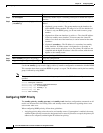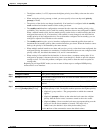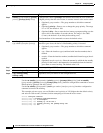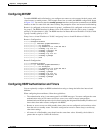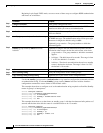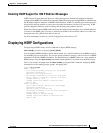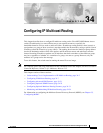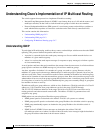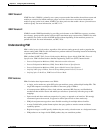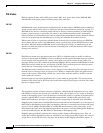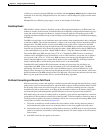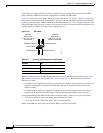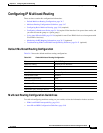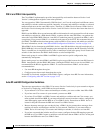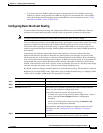
34-2
Cisco ME 3400 Ethernet Access Switch Software Configuration Guide
78-17058-01
Chapter 34 Configuring IP Multicast Routing
Understanding Cisco’s Implementation of IP Multicast Routing
Understanding Cisco’s Implementation of IP Multicast Routing
The switch supports these protocols to implement IP multicast routing:
• Internet Group Management Protocol (IGMP) is used among hosts on a LAN and the routers (and
multilayer switches) on that LAN to track the multicast groups of which hosts are members.
• Protocol-Independent Multicast (PIM) protocol is used among routers and multilayer switches to
track which multicast packets to forward to each other and to their directly connected LANs.
This section contains this information:
• Understanding IGMP, page 34-2
• Understanding PIM, page 34-3
• Configuring IP Multicast Routing, page 34-7
Understanding IGMP
To participate in IP multicasting, multicast hosts, routers, and multilayer switches must have the IGMP
operating. This protocol defines the querier and host roles:
• A querier is a network device that sends query messages to discover which network devices are
members of a given multicast group.
• A host is a receiver that sends report messages (in response to query messages) to inform a querier
of a host membership.
A set of queriers and hosts that receive multicast data streams from the same source is called a multicast
group. Queriers and hosts use IGMP messages to join and leave multicast groups.
Any host, regardless of whether it is a member of a group, can send to a group. However, only the
members of a group receive the message. Membership in a multicast group is dynamic; hosts can join
and leave at any time. There is no restriction on the location or number of members in a multicast group.
A host can be a member of more than one multicast group at a time. How active a multicast group is and
what members it has can vary from group to group and from time to time. A multicast group can be active
for a long time, or it can be very short-lived. Membership in a group can constantly change. A group that
has members can have no activity.
IP multicast traffic uses group addresses, which are class D addresses. The high-order bits of a Class D
address are 1110. Therefore, host group addresses can be in the range 224.0.0.0 through
239.255.255.255. Multicast addresses in the range 224.0.0.0 to 24.0.0.255 are reserved for use by
routing protocols and other network control traffic. The address 224.0.0.0 is guaranteed not to be
assigned to any group.
IGMP packets are sent using these IP multicast group addresses:
• IGMP general queries are destined to the address 224.0.0.1 (all systems on a subnet).
• IGMP group-specific queries are destined to the group IP address for which the switch is querying.
• IGMP group membership reports are destined to the group IP address for which the switch is
reporting.
• IGMP Version 2 (IGMPv2) leave messages are destined to the address 224.0.0.2
(all-multicast-routers on a subnet). In some old host IP stacks, leave messages might be destined to
the group IP address rather than to the all-routers address.



